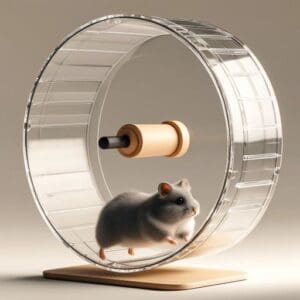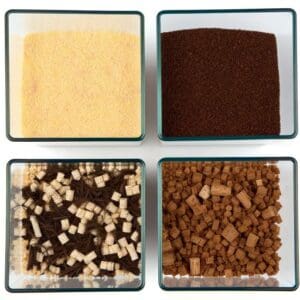I’m going to be your guide in setting up a comfortable and enriching home for your tiny friend, the dwarf hamster. Don’t worry too much about getting it perfect from the get-go; you can always adjust your approach down the road. But choosing the right enclosure is a cornerstone of a happy hamster life.
Choosing the Right Enclosure
- Size Matters: An enclosure like the Ikea Linnmon has become a hit amongst hamster enthusiasts. Why? It’s spacious, offering 858 square inches of exploration bliss. Commit to a large space; a 40 by 20-inch floor plan is the least you should go for to avoid cramping your pet’s style. A dwarf hamster might be small, but their needs for movement and play are anything but.
- Ventilation: When it comes to ventilation, this isn’t just about keeping the air fresh – it’s also about your hamster’s health. Adequate airflow is vital to prevent dampness and control the buildup of ammonia from their waste. Choose an enclosure with a well-ventilated design, ensuring a breath of fresh air for your furry companion.
- Utilizing the Space: Today, I’m going to be talking about more than just habitable space; I’m focused on making the cage a dwarf hamster’s sanctuary. It’s not the size alone that counts; it is how you use the space. With expert tips to craft an environment that caters to their natural instincts, your pet is going to thrive.
Creating a Comforting Burrow: Bedding and Hideouts
In my opinion, a comfortable burrow is the heart of a dwarf hamster’s home. It’s not just a place to sleep; it’s a haven for them to feel secure, a space to explore, and a crucial part of their natural behavior. That’s why prioritizing the right bedding and hideout structure is so important.
 Essential Bedding: You’re going to find out about how a deep layer of bedding is essential. At least 8-10 inches of bedding like paper, Aspen, hemp, or Spruce shavings provides the depth needed for your hamster to dig and burrow as they would in the wild. Plus, it’s important to pack this bedding tightly to support the intricate tunnels they love to create.
Essential Bedding: You’re going to find out about how a deep layer of bedding is essential. At least 8-10 inches of bedding like paper, Aspen, hemp, or Spruce shavings provides the depth needed for your hamster to dig and burrow as they would in the wild. Plus, it’s important to pack this bedding tightly to support the intricate tunnels they love to create.- Hideout Dynamics: Next up is installing a multi-chamber hideout. Mimicking their wild burrows, this feature adds a layer of realism to their captive environment. And don’t forget the safety aspect; placing the hideout on stilts using platforms can prevent any accidents if they dig underneath. . You can always adjust your approach down the road, but starting off with this safety measure is a smart move.
Choose something that resonates with your hamster’s need for a natural environment, and you’ll see the difference in their behavior. A proper burrow increases their sense of security and provides them with hours of digging and nesting activities.
Cage Setup Enhancements for Behavioral Enrichment
I’m going to guide you through enhancing your dwarf hamster’s cage setup to promote natural behavior and overall enrichment. You’re going to find out about selecting the right exercise wheel and why its size matters for your tiny pal’s health.
 Exercise Wheel: First, I would recommend an 11-inch wheel, which allows your hamster to run with a straight back, eliminating spinal strain. At the same time, mounting the wheel on a platform within the bedding keeps it stabilized and prevents it from being buried under substrate.
Exercise Wheel: First, I would recommend an 11-inch wheel, which allows your hamster to run with a straight back, eliminating spinal strain. At the same time, mounting the wheel on a platform within the bedding keeps it stabilized and prevents it from being buried under substrate.- Diverse Substrates: Don’t worry too much about the initial configuration. You can always adjust your approach down the road. But for now, let’s focus on the variety of substrates you can use. Adding different textures like cork granules, coconut fiber, or cocoa bark isn’t just for aesthetics; it’s also about providing diverse sensory experiences that mimic their natural environments. It can be added in little containers which gives your hamster the chance to walk and
 interact with a different texture. Choose something that resonates with you and your hamster. Spread these substrates throughout the enclosure, but bear in mind, focus on non-burrowing areas to maintain the integrity of their tunnels and chambers.
interact with a different texture. Choose something that resonates with you and your hamster. Spread these substrates throughout the enclosure, but bear in mind, focus on non-burrowing areas to maintain the integrity of their tunnels and chambers. - Hygiene and Additional Elements: Now, let’s talk about providing a sand bath, a crucial element for your dwarf hamster’s hygiene and well-being. Use a sizable container and fill it with dye-free and calcium-free sand to avoid any respiratory issues or other health complications. But we’re not stopping there. Introduce additional elements such as herbs and natural chews to the enclosure. These materials offer both dietary variety and essential dental health support, making your hamster’s day both interesting and beneficial.
Elevating Well-Being Through Supplementary Enrichment
 Structural Enrichments: You’ve put in the work to set up a stellar habitat—now it’s time to elevate it with additional enrichment that considers your dwarf hamster’s comprehensive welfare. Platforms and bridges aren’t just architectural feats in the small world of your hamster’s enclosure; they serve a much greater purpose.
Structural Enrichments: You’ve put in the work to set up a stellar habitat—now it’s time to elevate it with additional enrichment that considers your dwarf hamster’s comprehensive welfare. Platforms and bridges aren’t just architectural feats in the small world of your hamster’s enclosure; they serve a much greater purpose.- Safety and Exploration: By strategically placing these elements, you ensure that essentials like the exercise wheel and water station remain pristine and that the environment remains dynamic and engaging. Secure all bridges firmly, and make sure that any gaps are covered with sphagnum moss to prevent little legs from getting stuck.
- Sensory and Dietary Diversity: Beyond safety, these moss varieties offer a
 delightful twist, giving your pet new textures to explore and soft materials perfect for nesting. Chew toys are more than diversions; they are fashioned from safe woods or loofah, well-distributed in the area to inspire adventure and satisfy the natural gnawing instinct. Lastly, sprinkle in the charm of diverse flora. Adding herbs like chamomile and dandelion not only diversifies the diet but also adds a sensory layer to your hamster’s habitat. These safe-to-consume plants offer new scents and textures, stirring up your pet’s environment in the most natural way.
delightful twist, giving your pet new textures to explore and soft materials perfect for nesting. Chew toys are more than diversions; they are fashioned from safe woods or loofah, well-distributed in the area to inspire adventure and satisfy the natural gnawing instinct. Lastly, sprinkle in the charm of diverse flora. Adding herbs like chamomile and dandelion not only diversifies the diet but also adds a sensory layer to your hamster’s habitat. These safe-to-consume plants offer new scents and textures, stirring up your pet’s environment in the most natural way.
Think of your dwarf hamster’s cage not as a simple home but as a canvas for creativity – one that you can always adjust and add to over time. Aim for a setup that not only ensures your hamster’s health and safety but also promotes an environment rich in opportunities for exploration and natural behaviors. You can feel good knowing that every addition contributes to their physical, mental, and emotional enrichment.
